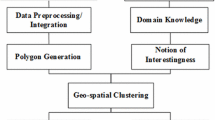Abstract
Spatiotemporal data mining has many important applications in environmental modelling. This paper introduces a modified algorithm for spatiotemporal data mining based on density-based spatial clustering of applications with noise (DBSCAN). Based on the modified algorithm, a geographic information system (GIS) add-in was developed using ArcObjects and C#, and is freely available for download. Compared with some existing methods, the new method can perform automated detection of spatiotemporal clusters using limited user input parameters. The application of the add-in was demonstrated using summer temperature data collected from 104 weather stations in southwest China from 1961 to 2011. The results suggest that the modified algorithm can provide more detailed partition of temperature zones compared with some existing methods.






Similar content being viewed by others
References
Aggarwal CC (2015) Mining spatial data. In: Data mining. Springer, New York, NY. pp 531–555
Atluri G, Karpatne A, Kumar V (2018) Spatio-temporal data mining: a survey of problems and methods. CAN Computing Surveys (CSUR) 51(4):1–41. https://doi.org/10.1145/3161602
Bilgin TT, Çamurcu AY (2004) A data mining application on air temperature database. Third International Conference on Advances in Information Systems (ADVIS 2004), Izmir, Turkey, October 20-22, 2004
Cressie N, Wikle CK (2015) Statistics for spatio-temporal data. Wiley, Hoboken, NJ
Duan ZF (2015) Spatiotemporal patterns of summer temperature in Southwest China from 1951-2013. Beijing Agriculture, Vol. 29. (in Chinese)
Esling P, Agon C (2012) Time-series data mining. ACM Comput Surv 45(1):12
Ester M, Kriegel H-P, Sander J, Xu X (1996) A density-based algorithm for discovering clusters in large spatial databases with noise. In: Proceedings of the ACM SIGKDD conference on knowledge discovery and data mining (SIGKDD’96), vol 96, pp 226–231
Faghmous JH, Kumar V (2014) Spatio-temporal data Mining for Climate Data: advances, challenges, and opportunities. In: Chu WW (ed) Data mining and knowledge discovery for big data, pp 83–116
Ganguly AR, Steinhaeuser K (2008) Data Mining for Climate Change and Impacts. 2008 IEEE international conference on data mining workshops. December 15–19, 2008. Pisa, Italy. https://doi.org/10.1109/ICDMW.2008.30
Kawale J, Liess S, Kumar V, Lall U, Ganguly A (2012) Mining time-lagged relationships in spatio-temporal climate data. 2012 Conference on Intelligent Data Understanding, October 24–26, 2012. Boulder, CO, USA. pp.130–135
Keogh E, Kasetty S (2003) On the need for time series data mining benchmarks: a survey and empirical demonstration. Data Min Knowl Disc 7:349–371
Lian J, McGuire MP (2016) Mining persistent and dynamic Spatio-temporal change in global climate data. 13th International Conference on Information Technology. April 2016, Las Vegas, USA
Liao TW (2005) Clustering of time series data - a survey. Pattern Recogn 38:1857–1874
Loglisci C, Ceci M, Impedovo A, Malerba D (2016) Mining Spatio-temporal patterns of periodic changes in climate data. International workshop on new Frontiers in mining complex patterns. Riva del Garda, Italy, September 19, 2016. pp 198–212
Shekhar S, Chawla S (2003) Spatial databases: a tour. NJ: Prentice hall, Upper Saddle River, p 2003
Shekhar S, Vatsavai RR, Celik M (2008) Spatial and spatiotemporal data mining: recent advances. In: Data mining: next generation challenges and future directions, pp 1–34
Shekhar S, Evans MR, Kang JM, Mohan P (2011) Identifying patterns in spatial information: a survey of methods. Data Min Knowl Disc 1:193–214
Acknowledgements
This work is supported by the National Natural Science Foundation of China (No. 41461103) and a research fund of Yunnan University (C176240210019).
Author information
Authors and Affiliations
Corresponding author
Additional information
Communicated by: H. Babaie
Publisher’s note
Springer Nature remains neutral with regard to jurisdictional claims in published maps and institutional affiliations.
Software files
The GIS add-in can be downloaded from http://www.srees.ynu.edu.cn/info/1040/2178.htm.
Right click the link to ArcMapAddin5.rar to download the archive, then extract files from the archive to get the add-in file “ArcMapAddin.esriAddin”. To install the add-in for ArcMap 10.x, users can open ArcMap, go to the Customize menu, then select Add-in Manager. Click the Options tab in the Add-in Manager, then click the Add Folder button to add the folder for “ArcMapAddin.esriAddin”. Click the Customize button at the bottom of the Add-in Manager, then select the second tab “Commands”. Select “Add-in Controls” in the Categories list, then drag “SMKDBSCAN” from the Commands list to an ArcMap toolbar. Click the SMKDBSCAN icon to start using the add-in.
Rights and permissions
About this article
Cite this article
Xia, J., Li, J., Dong, P. et al. An ArcGIS add-in for spatiotemporal data mining in climate data. Earth Sci Inform 13, 185–190 (2020). https://doi.org/10.1007/s12145-019-00404-0
Received:
Accepted:
Published:
Issue Date:
DOI: https://doi.org/10.1007/s12145-019-00404-0




